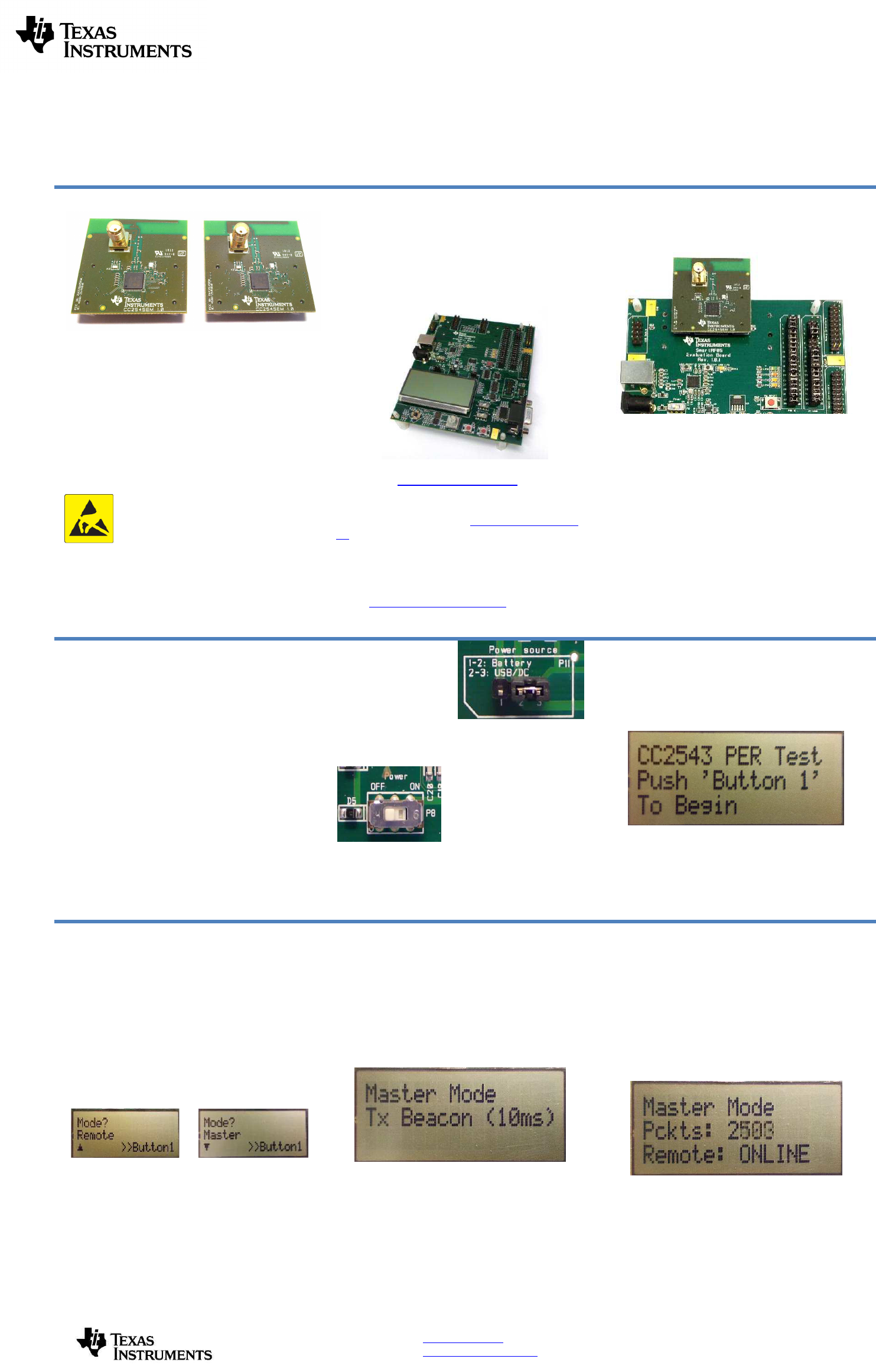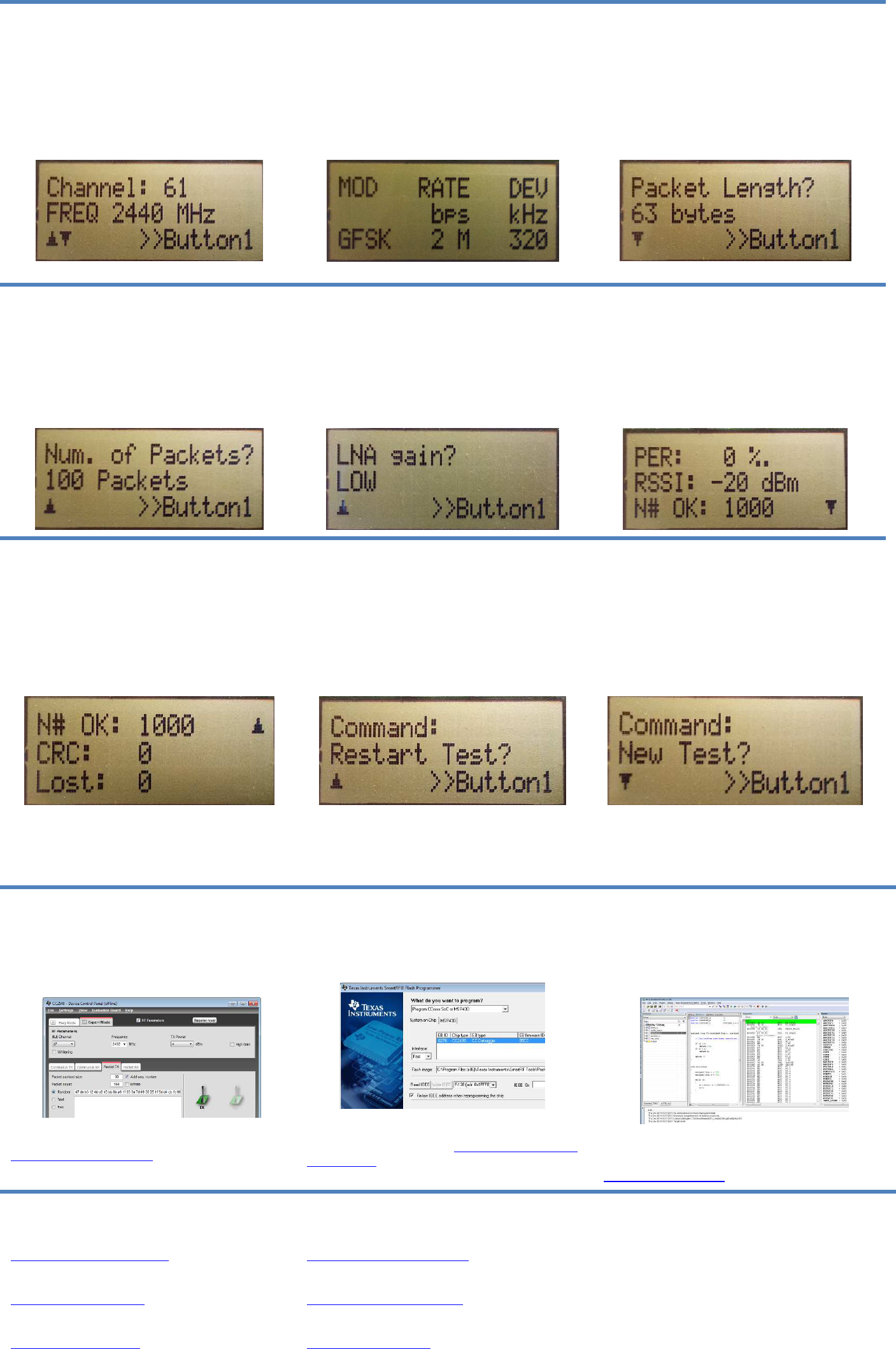Texas Instruments 2545EM The CC2545EM is a development tool for TIs 2.4 GHz CC2545 proprietary System-on-Chip. User Manual CC2545EMK Quick Start Guide
Texas Instruments Inc. The CC2545EM is a development tool for TIs 2.4 GHz CC2545 proprietary System-on-Chip. CC2545EMK Quick Start Guide
User manual

SWRUXXX
April 2012
Web sites: www.ti.com/lprf
E2E Forum: www.ti.com/lprf-forum
Make sure to subscribe to the Low-Power RF
Newsletter to receive information about updates to
documentation, new product releases, and more.
Sign up on the TI web pages.
CC2545EMK Quick Start Guide
Opening the Box and Running the Packet Error Rate Test Application
1. Kit Contents
• 2 x CC2545 Evaluation Modules (EM)
• Documentation
The RF boards in this kit are FCC and IC
certified and tested/complies with ETSI/R&TTE
over temperature from 0 to +35°C. There is an
on-board PCB antenna on the evaluation
module. This kit is a
Caution! The kit contains ESD
sensitive components. Handle with
care to prevent permanent damage.
2. Hardware Requirements
To run the example described in this Quick Start
Guide, you would need either two CC2545EMs
mounted on SmartRF05 Evaluation Boards
(SmartRF05EB - Rev 1.8.1 or later).
SmartRF05EB is included in the CC2543-
CC2544 Development Kit.
More information about the SmartRF05EB can
be found in www.ti.com/lit/swru210.
The CC2545EM boards can also be plugged
into a battery board (see www.ti.com/tool/soc-
bb) for standalone operation.
The source code for the PER test can be
downloaded from the CC2545DK product
page (www.ti.com/tool/cc2545dk).
3. Hardware Setup
Mount the CC2545EMs firmly on to connectors
P5 and P6 on the SmartRF05EB.
Caution! To minimize risk of injury, avoid
touching components during operation if
symbolized as hot.
4. Power Options
There are several ways of applying power to the
SmartRF05EB.
• 2 x 1.5 V AA Alkaline Batteries
• USB
• External Power Supply
For the batteries and USB, there are voltage
regulators on the SmartRF05EB that will set the
on-board voltage to 3.3 V. The external power
supply should set a voltage that does not exceed
3.3 V. Note that there should only be one
active power source at any one time.
Warning! To minimize risk of personal injury or
property damage, never use rechargeable
batteries to power the board.
5. Power the
Boards
Find jumper P11 on
the top side of each
SmartRF05EB. This jumper is used to set the
power source for the board. Set P11 to “1-2” if
you are using battery power. Set P11 to “2-3” if
you are using USB or an
external power supply.
Once you have set P11,
find switch P8 on the top
side of each
SmartRF05EB. To power up the boards, flip the
switch from the “OFF” position to “ON”.
Do not leave EVM powered when
unattended.
6. Start-up Screen
The CC2545EMs are pre-loaded with a
Packet Error Rate (PER) test application.
The LCD screens on the two SmartRF05EBs
should display the messages below:
7. Choosing Mode
The application can be used between two
CC2545EM’s. There are two operating modes:
“Remote” and “Master”.
After button S1 is pushed at the start up screen,
the mode selection screen (showed below) will
appear. The Remote mode is shown by default.
Press the joystick up and down to change
between master and remote mode and press
button S1 to confirm.
In the Remote mode all the parameters for the
current PER test must be set up before the test
begins (go to step 10).
8. Master Mode (Beacon)
In “Master” mode, the radio will repeatedly (once
every 10 milliseconds) send out a “beacon”
signal (250 kbps, GFSK modulation, 160 kHz
deviation, 2402 MHz) and listen for a response
from the remote device. The Green LED1 will
blink continuously.
No more actions are needed from the user for
the master device to work.
9. Master Mode (PER test)
Once the beacon is acknowledged by the
“Remote”, the actual PER test begins. The PER
test configuration is included in the payload of
the acknowledge packet. The Master device
extracts this information and configures the radio
parameters accordingly. During the PER test,
packets are sent at a fixed repetition rate of 10
msec.
During the test the number of sent packets will
be updated on the LCD display as well as the link
status between the Master and Remote device.

10. Frequency Selection
When the Remote mode is chosen, a series of
settings must be configured to set up the link for
the PER test. The frequency must be selected
first (the selectable frequency range is from 2402
MHz to 2480 MHz). Move the joystick up or down
to change the frequency (channel) and press S1
to confirm the choice.
11. Modulation Setup
There are 7 different modulation schemes
available. The different bitrates are 250 Kbps,
500 Kbps, 1Mbps and 2 Mbps. MSK modulation
is available for 250 Kbps and 500 Kbps data rate
while GFSK has all of the mentioned above.
Move the joystick up or down to change the
scheme and press S1 to confirm the choice.
12. Packet Length
The packet length can be set to 10, 16, 32 or 63
bytes. Move the joystick up or down to change
the packet length and press S1 to confirm the
choice.
13. Number of Packets
The total number of packets to be sent for each
run can be set to 100, 1000, 10000, 100000 and
1000000. Move the joystick up or down to
change the number of packets and press S1 to
confirm the choice.
14. LNA Gain
For the 2Mbps data rates the AGC is enabled,
while for lower rates the LNA gain must be set to
HIGH or LOW. Move the joystick up or down to
change between LOW and HIGH gain and press
S1 to confirm the choice. After confirming the last
choice the configuration packet will be sent to the
Master device and the PER test begins.
15. Results I
The packet error rate (PER) is presented as the
sum of lost packets and packets with CRC error
per thousand. The received signal strength
indication (RSSI) is presented as a running
average of the five last samples. The number of
received packets is continuously updated on the
LCD display while the test is running.
13. Results II
When the test is complete a small downward
facing arrow will show in the bottom right of the
LCD screen. This indicates that the test is
complete and that there is an additional results
screen “below”. Move the joystick up and down
to jump between the two test result screens.
Press the S1 button to exit the test results.
14. Repeat Test
After exiting the test results the user is presented
with two choices. If “Restart Test” is chosen the
same test as previously run will be repeated. The
test can also be restarted at any time during the
test by pushing the S1 button. Move the joystick
up or down to switch between the two commands
and press S1 to confirm the choice.
15. New Test
If “New Test” is chosen the application will return
to setting up the configuration for a new test,
starting at frequency selection. The test can also
be stopped at any time during the test by pushing
on the joystick like a button.
Additional Tools and Links
SmartRF™ Studio
SmartRF Studio allows you to configure the radio,
run RF performance tests, and run link tests
between the two SmartRF05EBs.
SmartRF Studio can be downloaded from
www.ti.com/smartrfstudio
SmartRF Flash Programmer
Texas Instruments has a simple tool which can
be used to program and flash the CC2545.
SmartRF Flash Programmer can be
downloaded from www.ti.com/tool/flash-
programmer
IAR Embedded Workbench
To develop software, program, and debug the
CC2545, you should use IAR Embedded
Workbench for 8051.
More information on IAR EW8051, including a
free evaluation version download, can be found at
www.iar.com/ew8051.
Useful Links
CC2545EMK Product Page:
www.ti.com/tool/cc2545emk
CC2545EMK User’s Guide:
www.ti.com/lit/swruXXX
CC2543-CC2544DK User’s Guide:
www.ti.com/lit/swru318
Useful Links
CC2543/44/45 User’s Guide:
http://www.ti.com/lit/swru283
CC2545 Product Page:
www.ti.com/product/cc2545
For additional help, visit the TI E2E Forums:
www.ti.com/lprf-forum

EVALUATION BOARD/KIT/MODULE (EVM) ADDITIONAL TERMS
Texas Instruments (TI) provides the enclosed Evaluation Board/Kit/Module (EVM) under the following
conditions:
The user assumes all responsibility and liability for proper and safe handling of the goods. Further, the user
indemnifies TI from all claims arising from the handling or use of the goods.
Should this evaluation board/kit not meet the specifications indicated in the User’s Guide, the board/ kit may
be returned within 30 days from the date of delivery for a full refund. THE FOREGOING LIMITED
WARRANTY IS THE EXCLUSIVE WARRANTY MADE BY SELLER TO BUYER AND IS IN LIEU OF ALL
OTHER WARRANTIES, EXPRESSED, IMPLIED, OR STATUTORY, INCLUDING ANY WARRANTY OF
MERCHANTABILITY OR FITNESS FOR ANY PARTICULAR PURPOSE. EXCEPT TO THE EXTENT OF
THE INDEMNITY SET FORTH ABOVE, NEITHER PARTY SHALL BE LIABLE TO THE OTHER FOR ANY
INDIRECT, SPECIAL, INCIDENTAL, OR CONSEQUENTIAL DAMAGES.
Please read the User's Guide and, specifically, the Warnings and Restrictions notice in the User's Guide
prior to handling the product. This notice contains important safety information about temperatures and
voltages. For additional information on TI's environmental and/or safety programs, please visit
www.ti.com/esh or contact TI.
No license is granted under any patent right or other intellectual property right of TI covering or relating to
any machine, process, or combination in which such TI products or services might be or are used. TI
currently deals with a variety of customers for products, and therefore our arrangement with the user is not
exclusive. TI assumes no liability for applications assistance, customer product design, software
performance, or infringement of patents or services described herein.
Mailing Address: Texas Instruments Post Office Box 655303 Dallas, Texas 75265
Copyright 2011, Texas Instruments Incorporated
REGULATORY COMPLIANCE INFORMATION
As noted in the EVM User’s Guide and/or EVM itself, this EVM and/or accompanying hardware may or may
not be subject to the Federal Communications Commission (FCC) and Industry Canada (IC) rules.
For EVMs not subject to the above rules, this evaluation board/kit/module is intended for use for
ENGINEERING DEVELOPMENT, DEMONSTRATION OR EVALUATION PURPOSES ONLY and is not
considered by TI to be a finished end product fit for general consumer use. It generates, uses, and can
radiate radio frequency energy and has not been tested for compliance with the limits of computing devices
pursuant to part 15 of FCC or ICES-003 rules, which are designed to provide reasonable protection against
radio frequency interference. Operation of the equipment may cause interference with radio communications,
in which case the user at his own expense will be required to take whatever measures may be required to
correct this interference.
General Statement for EVMs including a radio
User Power/Frequency Use Obligations: This radio is intended for development/professional use only in
legally allocated frequency and power limits. Any use of radio frequencies and/or power availability of this
EVM and its development application(s) must comply with local laws governing radio spectrum allocation and
power limits for this evaluation module. It is the user’s sole responsibility to only operate this radio in legally
acceptable frequency space and within legally mandated power limitations. Any exceptions to this is strictly
prohibited and unauthorized by Texas Instruments unless user has obtained appropriate
experimental/development licenses from local regulatory authorities, which is responsibility of user including
its acceptable authorization.
SSZZ027 December 2011

For EVMs annotated as FCC – FEDERAL COMMUNICATIONS COMMISSION Part 15 Compliant
Caution
This device complies with part 15 of the FCC Rules. Operation is subject to the following two conditions: (1)
This device may not cause harmful interference, and (2) this device must accept any interference received,
including interference that may cause undesired operation.
Changes or modifications not expressly approved by the party responsible for compliance could void the
user's authority to operate the equipment.
FCC Interference Statement for Class A EVM devices
This equipment has been tested and found to comply with the limits for a Class A digital device, pursuant to
part 15 of the FCC Rules. These limits are designed to provide reasonable protection against harmful
interference when the equipment is operated in a commercial environment. This equipment generates, uses,
and can radiate radio frequency energy and, if not installed and used in accordance with the instruction
manual, may cause harmful interference to radio communications. Operation of this equipment in a
residential area is likely to cause harmful interference in which case the user will be required to correct the
interference at his own expense.
FCC Interference Statement for Class B EVM devices
This equipment has been tested and found to comply with the limits for a Class B digital device, pursuant to
part 15 of the FCC Rules. These limits are designed to provide reasonable protection against harmful
interference in a residential installation. This equipment generates, uses and can radiate radio frequency
energy and, if not installed and used in accordance with the instructions, may cause harmful interference to
radio communications. However, there is no guarantee that interference will not occur in a particular
installation. If this equipment does cause harmful interference to radio or television reception, which can be
determined by turning the equipment off and on, the user is encouraged to try to correct the interference by
one or more of the following measures:
Reorient or relocate the receiving antenna.
Increase the separation between the equipment and receiver.
Connect the equipment into an outlet on a circuit different from that to which the receiver is
connected.
Consult the dealer or an experienced radio/TV technician for help.
SSZZ027 December 2011

For EVMs annotated as IC – INDUSTRY CANADA Compliant
This Class A or B digital apparatus complies with Canadian ICES-003.
Changes or modifications not expressly approved by the party responsible for compliance could void the
user’s authority to operate the equipment.
Concerning EVMs including radio transmitters
This device complies with Industry Canada licence-exempt RSS standard(s). Operation is subject to the
following two conditions: (1) this device may not cause interference, and (2) this device must accept any
interference, including interference that may cause undesired operation of the device.
Concerning EVMs including detachable antennas
Under Industry Canada regulations, this radio transmitter may only operate using an antenna of a type and
maximum (or lesser) gain approved for the transmitter by Industry Canada. To reduce potential radio
interference to other users, the antenna type and its gain should be so chosen that the equivalent
isotropically radiated power (e.i.r.p.) is not more than that necessary for successful communication.
This radio transmitter has been approved by Industry Canada to operate with the antenna types listed in the
user guide with the maximum permissible gain and required antenna impedance for each antenna type
indicated. Antenna types not included in this list, having a gain greater than the maximum gain indicated for
that type, are strictly prohibited for use with this device.
~
Cet appareil numérique de la classe A ou B est conforme à la norme NMB-003 du Canada.
Les changements ou les modifications pas expressément approuvés par la partie responsable de la
conformité ont pu vider l’autorité de l'utilisateur pour actionner l'équipement.
Concernant les EVMs avec appareils radio
Le présent appareil est conforme aux CNR d'Industrie Canada applicables aux appareils radio exempts de
licence. L'exploitation est autorisée aux deux conditions suivantes : (1) l'appareil ne doit pas produire de
brouillage, et (2) l'utilisateur de l'appareil doit accepter tout brouillage radioélectrique subi, même si le
brouillage est susceptible d'en compromettre le fonctionnement.
Concernant les EVMs avec antennes détachables
Conformément à la réglementation d'Industrie Canada, le présent émetteur radio peut fonctionner avec une
antenne d'un type et d'un gain maximal (ou inférieur) approuvé pour l'émetteur par Industrie Canada. Dans
le but de réduire les risques de brouillage radioélectrique à l'intention des autres utilisateurs, il faut choisir le
type d'antenne et son gain de sorte que la puissance isotrope rayonnée équivalente (p.i.r.e.) ne dépasse pas
l'intensité nécessaire à l'établissement d'une communication satisfaisante.
Le présent émetteur radio a été approuvé par Industrie Canada pour fonctionner avec les types d'antenne
énumérés dans le manuel d’usage et ayant un gain admissible maximal et l'impédance requise pour chaque
type d'antenne. Les types d'antenne non inclus dans cette liste, ou dont le gain est supérieur au gain
maximal indiqué, sont strictement interdits pour l'exploitation de l'émetteur.
SSZZ027 December 2011

【Important Notice for Users of this Product in Japan】
This development kit is NOT certified as Confirming to Technical Regulations of
Radio Law of Japan!
If you use this product in Japan, you are required by Radio Law of Japan to follow the instructions below with
respect to this product:
(1) Use this product in a shielded room or any other test facility as defined in the notification #173
issued by Ministry of Internal Affairs and Communications on March 28, 2006, based on Sub-section 1.1 of
Article 6 of the Ministry’s Rule for Enforcement of Radio Law of Japan,
(2) Use this product only after you obtained the license of Test Radio Station as provided in Radio
Law of Japan with respect to this product, or
(3) Use of this product only after you obtained the Technical Regulations Conformity Certification as
provided in Radio Law of Japan with respect to this product.
Also, please do not transfer this product, unless you give the same notice above to the transferee.
Please note that if you could not follow the instructions above, you will be subject to penalties of Radio Law
of Japan. Texas Instruments Japan Limited
(address) 24-1, Nishi-Shinjuku 6 chome, Shinjukku-ku, Tokyo, Japan
http://www.tij.co.jp
【ご使用にあたっての注意】
本開発キットは技術基準適合証明を受けておりません。
本製品のご使用に際しては、電波法遵守のため、以下のいずれかの措置を取っていただく必要がありますの
でご注意ください。
(1)電波法施行規則第6条第1項第1号に基づく平成18年3月28日総務省告示第173号で定められた
電波暗室等の試験設備でご使用いただく。
(2)実験局の免許を取得後ご使用いただく。
(3)技術基準適合証明を取得後ご使用いただく。
なお、本製品は、上記の「ご使用にあたっての注意」を譲渡先、移転先に通知しない限り、譲渡、移転でき
ないものとします。
上記を遵守頂けない場合は、電波法の罰則が適用される可能性があることをご留意ください。
日本テキサス・インスツルメンツ株式会社
東京都新宿区西新宿6丁目24番1号
西新宿三井ビル
http://www.tij.co.jp
SSZZ027 December 2011
SSZZ027 December 2011
EVALUATION BOARD/KIT/MODULE (EVM)
WARNINGS, RESTRICTIONS AND DISCLAIMERS
For Feasibility Evaluation Only, in Laboratory/Development Environments. Unless otherwise indicated,
this EVM is not a finished electrical equipment and not intended for consumer use. It is intended solely for
use for preliminary feasibility evaluation in laboratory/development environments by technically qualified
electronics experts who are familiar with the dangers and application risks associated with handling electrical
mechanical components, systems and subsystems. It should not be used as all or part of a finished end
product.
Your Sole Responsibility and Risk. You acknowledge, represent and agree that:
1. You have unique knowledge concerning Federal, State and local regulatory requirements (including but
not limited to Food and Drug Administration regulations, if applicable) which relate to your products and
which relate to your use (and/or that of your employees, affiliates, contractors or designees) of the EVM
for evaluation, testing and other purposes.
2. You have full and exclusive responsibility to assure the safety and compliance of your products with all
such laws and other applicable regulatory requirements, and also to assure the safety of any activities to
be conducted by you and/or your employees, affiliates, contractors or designees, using the EVM.
Further, you are responsible to assure that any interfaces (electronic and/or mechanical) between the
EVM and any human body are designed with suitable isolation and means to safely limit accessible
leakage currents to minimize the risk of electrical shock hazard.
3. You will employ reasonable safeguards to ensure that your use of the EVM will not result in any property
damage, injury or death, even if the EVM should fail to perform as described or expected.
4. You will take care of proper disposal and recycling of the EVM’s electronic components and packing
materials
Certain Instructions. It is important to operate this EVM within TI’s recommended specifications and
environmental considerations per the user guidelines. Exceeding the specified EVM ratings (including but not
limited to input and output voltage, current, power, and environmental ranges) may cause property damage,
personal injury or death. If there are questions concerning these ratings please contact a TI field
representative prior to connecting interface electronics including input power and intended loads. Any loads
applied outside of the specified output range may result in unintended and/or inaccurate operation and/or
possible permanent damage to the EVM and/or interface electronics. Please consult the EVM User's Guide
prior to connecting any load to the EVM output. If there is uncertainty as to the load specification, please
contact a TI field representative. During normal operation, some circuit components may have case
temperatures greater than 60 C as long as the input and output are maintained at a normal ambient
operating temperature. These components include but are not limited to linear regulators, switching
transistors, pass transistors, and current sense resistors which can be identified using the EVM schematic
located in the EVM User's Guide. When placing measurement probes near these devices during normal
operation, please be aware that these devices may be very warm to the touch. As with all electronic
evaluation tools, only qualified personnel knowledgeable in electronic measurement and diagnostics
normally found in development environments should use these EVMs
Agreement to Defend, Indemnify and Hold Harmless. You agree to defend, indemnify and hold TI, its
licensors and their representatives harmless from and against any and all claims, damages, losses,
expenses, costs and liabilities (collectively, "Claims") arising out of or in connection with any use of the EVM
that is not in accordance with the terms of the agreement. This obligation shall apply whether Claims arise
under law of tort or contract or any other legal theory, and even if the EVM fails to perform as described or
expected.
Safety-Critical or Life-Critical Applications. If you intend to evaluate the components for possible use in
safety critical applications (such as life support) where a failure of the TI product would reasonably be
expected to cause severe personal injury or death, such as devices which are classified as FDA Class III or
similar classification, then you must specifically notify TI of such intent and enter into a separate Assurance
and Indemnity Agreement.